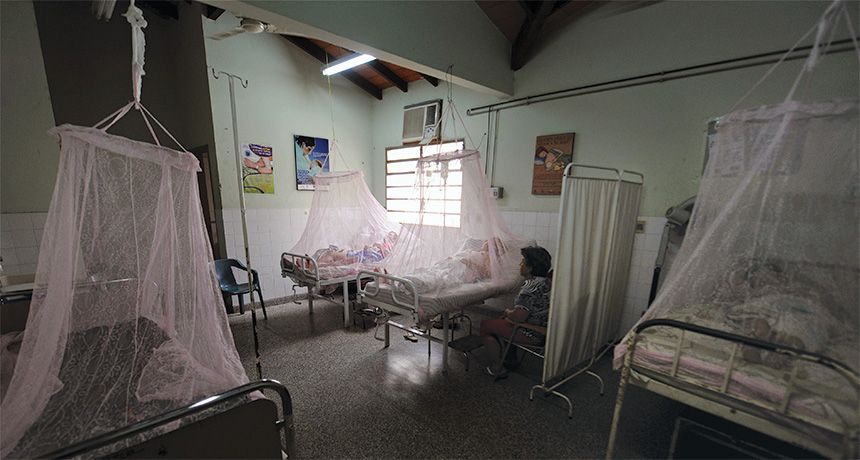Vaccines may offer defense against dengue, Zika and chikungunya

Humans can’t easily protect themselves from the most dangerous species on Earth. The predator slips invisibly into homes, quietly stalks its prey and bites before a victim knows what happened. There’s little chance of escape.
The attacker is Aedes aegypti, a mosquito that has, over time, developed a taste for people. It’s a city dweller that hovers in undisturbed crannies and can breed in a mere capful of water. Unlike some mosquitoes, which help themselves to a good meal and fly off satisfied, Ae. aegypti is a serial biter that can work through an entire family in minutes.
The lingering itch isn’t the problem; it’s the saliva transferred with each bite that could be loaded with thousands of virus particles, ready to multiply in the human body with little to stop it.
In the early 1900s, yellow fever, named for its hallmark jaundice and temperature spikes, was the most feared consequence of an Aedes bite. Outbreaks of the viral disease flared up with regularity in major port cities, and even delayed construction of the Panama Canal. After an effective vaccine was developed in the 1930s, yellow fever subsided and an emerging threat took its place: dengue, a flulike sickness so painful that it’s known as “breakbone fever.” For decades, dengue has reigned as the biggest Aedes-carried menace, now estimated to infect more than 50 million people a year in the Americas and almost 400 million worldwide.
Scientists are finally on the brink of introducing promising vaccines that might help control dengue, as well as newer mosquito-borne viral risks that now dominate public attention: Zika and chikungunya.
In December 2013, Ae. aegypti began spreading chikungunya virus in the Caribbean; by January 2015, an estimated 1 million people were infected in the Americas (SN: 6/13/15, p. 16). Then another worrisome Aedes hitchhiker, the Zika virus, began cutting a wide swath through South and Central America, causing devastating birth defects (SN Online: 4/13/16). So far, as many as 1.4 million people in Brazil alone may have contracted Zika.
For each of these infections, all doctors have to offer is pain relief and support. Although scientists are working on ways to remove disease-carrying mosquitoes (SN: 4/2/16, p. 30), controlling growing mosquito populations is looking less like a realistic option, according to reports from a March meeting of the World Health Organization: “There’s no evidence that any recent vector-control interventions, including massive spraying of insecticides, have had any significant effect on dengue transmission.”
In the absence of effective mosquito control, vaccines provide the best hope of winning the long game. Of the vaccines under study, the most challenging — and the one currently of broadest need — is dengue, which has proved exceptionally difficult to develop. After 70 years of effort, a dengue vaccine was approved in December for use in Mexico, the Philippines and Brazil. In April, the WHO threw its support behind the dengue shot. The vaccine has some shortcomings, but improved versions are not far behind. “I’m very optimistic — and I say this not just because I’ve been working on this for 16 years,” says Anna Durbin, a dengue vaccine researcher at the Johns Hopkins Bloomberg School of Public Health.
For the two infections that have the public on edge, Zika and chikungunya, vaccine development may be more straightforward. This fall, human tests should start of a vaccine that enlists just two Zika virus proteins to stimulate the immune system to fight the disease. One scientist calls the approach “simple and easy to manufacture.”
Dengue dangers
Although less of a headline grabber today, dengue has a long history of causing human suffering. Even Albert Sabin, famed developer of the oral polio vaccine, got involved in dengue vaccine development in the 1940s, just as the disease began its worldwide march.
Dengue is now thought to infect people in more than 100 countries (far more than Zika). Once bitten by an infected mosquito, a person’s symptoms can range from nothing at all, to tender, bloody splotches under the skin, to cardiovascular collapse and death.
Vaccine development is tricky because dengue is caused by four viruses, each slightly different but all capable of causing disease on their own. While infection with one version, called a serotype, is thought to confer lifelong immunity against that serotype, a subsequent infection from a different serotype can be worse than the first. The second time around, leftover antibodies from the first episode can sometimes turn traitor, enhancing growth of the virus inside the body.
This one-two punch can lead to unyielding forms of dengue, including potentially fatal hemorrhagic fever. “In 95 percent of people who have very severe disease, it’s because they’ve gotten a second infection of a different type,” says Stephen Thomas of the Walter Reed Army Institute of Research in Silver Spring, Md. “If you get infected with dengue 1, and five years later you get another dengue 1, we believe you’ll be protected. If you get infected with dengue 2, there are biological processes that increase your chances of severe disease.” The same goes for types 3 and 4. And the risk probably lasts a lifetime — or until a person is infected with all four serotypes.
Scientists have attempted to develop a dengue vaccine that both simultaneously and evenly provides immunity to all four dengue viruses. “Most people say if a vaccine works even just a little bit, it’s better than nothing,” Durbin says. In the case of dengue, however, “a bad vaccine can be worse than no vaccine. You may actually predispose people to more severe disease.”
About half a dozen dengue vaccines are in development. The first approved vaccine is Dengvaxia, made by French pharmaceutical manufacturer Sanofi Pasteur. The vaccine is built on a “backbone” of the yellow fever virus vaccine, drawing on that shot’s long history of success. In 25 clinical trials involving more than 40,000 participants, protection against dengue ranged from 77 percent against dengue serotype 4, to 43 percent against serotype 2, which is considered the hardest to guard against.
The vaccine is far from ideal. It is only for people ages 9 to 45 in dengue-hit areas. Yet small children bear a huge burden of disease. In Asia, where dengue has a long history, a study published March 24 in the New England Journal of Medicine found 10 percent of all fevers in children ages 2 to 16 were due to dengue; 19 percent of those required hospitalization.
But the vaccine may put some children in danger. In one clinical trial, immunization appeared to increase the risk of younger children going to the hospital for dengue the following year. Writing in the January issue of Nature Reviews Microbiology, Sanofi scientists hypothesized that the immune response from the vaccine mimicked a first infection in some of the littlest patients, predisposing them to the dangers of a second round of illness.
Other vaccines in the pipeline, such as one by the U.S. Centers for Disease Control and Prevention and Inviragen (now Takeda Pharmaceuticals), use a weakened form of the four live dengue viruses. In December 2015, researchers writing in the Journal of Infectious Diseases described a human test of the vaccine in Puerto Rico, Colombia, Singapore and Thailand. Among 148 volunteers ages 1 to 45, one or two doses of vaccine produced an immune response against all four types that ranged from 72 to 100 percent protection, based on the level of antibody present in the bloodstream. Even in volunteers who had been infected with dengue in the past, the vaccine did not raise safety concerns.
A dengue vaccine developed at the National Institutes of Health and tested at Johns Hopkins and the University of Vermont is in phase III trials, the last and largest phase of experimental testing. That vaccine is also made from a weakened version of live dengue viruses and requires only one dose. In early studies, the vaccine appeared to confer only weak protection to serotype 2, which might leave a gaping hole in immune defense.
However, a reassuring study was published in March in Science Translational Medicine. Durbin and colleagues gave 21 volunteers the NIH dengue vaccine. Six months later, they gave dengue 2 virus to the vaccinated group, as well as 20 volunteers who were not immunized. None of the vaccinated volunteers showed signs of virus in their blood, or a rash. Yet all 20 unvaccinated volunteers had positive blood tests and 80 percent had a rash. “We knew the dengue 2 component was weaker,” Durbin says. “Our question was, ‘Are we going to protect people from dengue 2?’ Challenge study said ‘yes.’ ”
Activating against Zika
In the current Zika epidemic, some scientists have theorized that dengue and Zika may be partners in crime, interacting in some way that allows the Zika virus to cross the placenta. For all its mysteries, this much is known: Before the Zika virus arrived in Brazil, it was not known to cause birth defects.
Although Zika virus has caused sporadic outbreaks since the 1940s, starting in Uganda, the numbers were small, and the disease was considered minor. Zika did not become a public health emergency until it crossed the ocean in 2014. Upon reaching Brazil in 2015, the virus spread explosively. It became linked to neurological problems (SN: 4/2/16, p. 29) and tragedies such as microcephaly in newborns (SN: 4/2/16, p. 26). Before Zika, the incidence of microcephaly in Brazil was 0.5 per 10,000 births. Today, the birth defect occurs in 20 of every 10,000 births, although those estimates are inexact because of unclear reporting before Zika.
“We were surprised when we saw what a devastating disease it was,” says Jorge Kalil, director of the Butantan Institute in São Paulo, Brazil’s premier institution for vaccine research and development. “Why do we have it? We still don’t know.”
On the vaccine front, there is reason for optimism. For one, after the infection clears, a person is thought to have lifelong protection against Zika, so lasting immunity appears possible. The Zika virus is made up of 10 proteins, but the immune system mostly responds to just two that protrude from the virus’s outer surface. Scientists at the National Institute of Allergy and Infectious Diseases in Bethesda, Md., are making a vaccine that consists of the genes that encode these two proteins. In theory, once inside the body, a person’s own cells would manufacture copies of the two Zika proteins, assemble them and trigger an immune response.
“It’s like you’re making your own viruslike particle,” says Julie Ledgerwood, chief of the clinical trials program at the NIH’s vaccine research center. The particle looks like a piece of virus — called an antigen — that is just enough to activate the immune system but not enough to cause disease. It’s a straightforward technology successfully tested against West Nile virus, another mosquito-borne infection, and described in a study published in 2011 in the Journal of Infectious Diseases. In that experiment, 30 volunteers received a vaccine that contained the genes for the outer coat of West Nile and their bodies began making antibodies to the virus.
Still, even if human testing of a Zika immunization begins this fall, a vaccine could take years to work through the approval process. Kalil says that Butantan researchers in Brazil need options sooner, especially for pregnant women. Instead of asking the body to develop antibodies in response to a vaccine, the researchers are investigating whether laboratory-made antibodies that fight Zika, when given to an infected pregnant woman, might shield her baby from infection. It’s an unorthodox approach, he says, but his agency feels an urgency to protect infants who can’t wait for the vaccine research to run its course.
“Time is crucial,” Kalil says. Already, Brazilian health authorities have confirmed more than 1,100 cases of microcephaly tied to Zika exposure. If a woman received a vaccine after she was already infected, her body would not have enough time to develop her own antibodies before the fetus is damaged, he says.
His institute is also developing a vaccine with whole, killed Zika virus. “It’s very basic, and we know it is safe,” he says, because the virus is dead. The killed virus may eventually be combined with a dengue vaccine.
Ready for chikungunya’s resurgence
As with Zika, experts believe one infection from chikungunya leaves lasting protection — a key reason that the epidemic in the Americas has largely subsided for now.
Chikungunya virus was first identified in the 1950s on the Makonde Plateau in Africa. Its name is roughly translated as “that which bends up,” a reference to the excruciating joint pain that can accompany infection. In December 2013, for reasons still not known, it leaped to another hemisphere, quickly spreading to South and Central America, lapping at the U.S. border. While rarely fatal, the disease can cause sore joints and arthritis long after a person’s initial recovery.
More than 15 different chikungunya vaccines are in various stages of development, employing almost every known approach to vaccine innovation, according to researchers from the University of Texas Medical Branch in Galveston writing in June in the journal Vaccine. The field has suffered some disappointments. The first vaccine to be tested in people used a weakened live version of the virus. Its development was halted in the early 2000s. Some early volunteers experienced joint pain, and studies raised concerns that the virus could gain strength — perhaps easier for chikungunya than other viruses because it can do so with just a few mutations.
The majority of chikungunya vaccines involve the use of weakened or killed virus. Only two have been tested in humans, and just one of those is currently in clinical trials.
The human trial in progress, led by NIH’s Ledgerwood, tests a vaccine similar to the Zika vaccine. Her team is injecting just a few genes from the chikungunya virus’s outer coat, allowing the body’s own cells to make a piece of virus. The tricky part of the technology, she says, is to make sure that the three proteins coded by the viral genes get assembled in the correct order so the immune system mistakes them for an actual virus.
Among 25 people who received three doses of the vaccine, two doses triggered a vigorous immune response, the researchers reported in The Lancet in 2014. No one developed serious side effects. The NIH team is recruiting 400 volunteers in the Caribbean — half will receive the vaccine and be compared with their unvaccinated neighbors.
Scott Weaver, director of the Institute for Human Infections and Immunity at the University of Texas Medical Branch at Galveston, is heading a team investigating a newer version of a live, weakened virus. Tests indicate that the virus used in this vaccine is more genetically stable than many strains, and unlikely to strengthen over time. Last year, in PLOS Neglected Tropical Diseases, Weaver and colleagues reported that in animal tests, the virus passed through five different generations of mice and did not show signs of mutating into a more virulent form. Weaver hopes the results help clear the way for studies in people.
The current chikungunya epidemic has been waning, causing just over 100,000 suspected cases this year in the Caribbean and Latin America. With little disease to protect against, a vaccine trial is hard to conduct. But most predict that the lull is only temporary.
“Chikungunya is not going away,” Weaver says. “We are on the back end of the current epidemic, but there will be another one coming, and we hope to have a vaccine ready in time.”
Extra hurdles
If the epidemics aren’t brought under control, there’s fear that the viruses could migrate from Ae. aegypti into its cousin Aedes albopictus, the Asian tiger mosquito, which is more widespread in the cooler climates of the United States (SN Online: 5/16/16; SN: 6/29/13, p. 26). Asian tiger mosquitoes have already shown they are capable of spreading Zika, as they did in a 2007 outbreak in Gabon. They also spread chikungunya in an outbreak on the island of Réunion in 2005.
If there is one lesson from yellow fever, it is that science is not the only hurdle. Vaccines must overcome tests of logistics, politics and economics. After generations of control, yellow fever emerged in Angola and other parts of Africa in January and is spreading. As of June 1, Angola had 2,893 suspected cases and 325 people had died. Yellow fever vaccine is in short supply, and it’s unclear how soon manufacturers can ramp up production.
Writing in JAMA on May 9, two professors from Georgetown University’s O’Neill Institute for National and Global Health Law asked the WHO to “urgently convene an emergency committee to mobilize funds, coordinate an international response and spearhead a surge in [yellow fever] vaccine production.”
While not declaring the yellow fever escalation an emergency, Margaret Chan, WHO’s director-general, told the United Nations general assembly on May 23 that the spread of Zika, dengue and chikungunya are the price being paid for policies that dropped the ball on mosquito and disease control.
“The lesson from yellow fever is especially brutal,” she said. “The world failed to use an excellent preventive tool to its full strategic advantage.” After all, a vaccine is no good if the people in need don’t receive it.


